Biryani: Is It Pakistani or Indian?

People love to argue about biryani. Ask anyone from Karachi or Hyderabad, and you’ll get a passionate answer about whether the best biryani is Pakistani or Indian—or even who made it first. It's a fair question because biryani is more than just food. It's loaded with history, cultural pride, family bragging rights, and, let’s be honest, some serious friendly rivalry.
If you care about making great biryani at home, it helps to know where it comes from and what makes each style unique. That way, you can pick up the tricks that matter for your own kitchen. Some people get hung up on origin stories and grandma’s exact recipe. Here’s the thing: knowing why Karachi biryani feels spicy and bold, or why Hyderabadi biryani is all about layering and patience, gives you an edge in cooking biryani you actually crave.
So, why should you pick one version over the other? The truth is, understanding the flavors and history behind biryani means you’re never lost when trying a new recipe—plus you’ll never run out of ways to tweak things for your own family. At my place, Priya and I have had more debates over biryani than any other meal, but those arguments always end with empty plates and happy faces. Biryani does that to people.
- Biryani’s Ancient Roots
- Regional Twists and Rivalries
- What Makes Pakistani Biryani Special?
- Indian Biryani: Regional Legends
- Making Biryani at Home: Quick Tips
Biryani’s Ancient Roots
The story behind biryani is a real tangled one. Most food historians agree that biryani didn’t just pop up overnight in either India or Pakistan. Its foundations go all the way back to Persian and Arab influences, thanks to travelers and traders who passed through the Indian subcontinent centuries ago. The word “biryani” probably comes from the Persian words “birian” (which means fried) and “birinj” (which means rice). That already hints at a Persian connection long before India or Pakistan were even countries.
Legend says that biryani showed up in India during the Mughal Empire. These Mughal emperors loved rich food and brought their cooks and cooking styles with them from Central Asia and Persia. By the late 1500s, early versions of biryani started appearing in royal kitchens from Delhi to Hyderabad. The Mughal cooks combined fragrant rice with spiced meats, nuts, and dried fruits, putting that special twist we now think of as classic biryani.
But here’s where things get interesting: both modern Pakistan and India were part of the same territory under Mughal rule, so it’s nearly impossible to say biryani is "more" Pakistani or "more" Indian. Back then, regional ingredients started making their mark. The rice stayed consistent, but cooks used what they found locally: goat, chicken, or beef in some places, lamb in others, and different blends of spices depending on what was available. No matter where, though, the method of layering rice and meat—the real trademark of biryani—became the big move that stuck.
If you look at old records, experts say early biryani recipes often included yogurt-based marinades and saffron for that color and kick. Even today, those details show up everywhere—in both Pakistani biryani and Indian biryani. So, if you hear someone claim their family invented biryani, you can smile knowing this dish is the product of centuries of mixing, trading, and a lot of trial and error.
Regional Twists and Rivalries
If you travel around South Asia, you’ll notice that every city claims its biryani is the best. But it’s not just about bragging rights—these regional biryanis taste pretty different from each other. Karachi, Lahore, Hyderabad (India), Kolkata, Lucknow—they’ve all got their own spin, and people are loyal to what they grew up eating.
The main rivalry is between Pakistani biryani and Indian biryani. In Pakistan, Karachi biryani is known for its heat—red chili brings the fire, and there’s always a burst of aroma from strong spices and potatoes. In India, Hyderabadi dum biryani is super famous for its slow-cooked, layered style. Each spoonful tastes different because of how the meat and rice soak up flavors while they steam together. Lucknow (Awadhi) biryani goes for a milder, fragrant mix and is usually not as spicy.
As chef Kunal Kapur once said, “There’s no ‘right’ way to make biryani, only the way that makes your family happy.”
Here’s a quick breakdown of some well-known styles:
- Karachi Biryani: Bold, spicy, uses tomatoes and potatoes. Chicken or beef is most common.
- Lahori Biryani: Spicier than Karachi’s, often with a tangy touch from yogurt or dried plums.
- Hyderabadi Biryani: Layered, slow-cooked, uses either raw or cooked meats, always aromatic.
- Kolkata Biryani: Lighter, uses potato chunks and boiled eggs, often subtle and less oily.
- Lucknow (Awadhi) Biryani: Mild spices, fragrant, more about saffron and whole spices than heat.
Check out the differences in a handy comparison:
| Style | Key Protein | Main Spice Note | Unique Feature |
|---|---|---|---|
| Karachi | Chicken/Beef | Chili-heavy | Potatoes, tomatoes |
| Hyderabadi | Mutton/Chicken | Aromatic, layered | Slow-cooked "dum" method |
| Kolkata | Chicken/Mutton | Mild, subtle | Potatoes, boiled eggs |
Understanding these twists makes it way easier to pick or tweak a biryani recipe at home. Just remember, loyalties run deep—so if you’re cooking for a Pakistani and Indian crowd at the same table, get ready for a lively debate!

What Makes Pakistani Biryani Special?
You can always tell when you’re eating Pakistani biryani. It packs a punch and doesn’t apologize for its flavor or heat. This isn’t just about spice—it’s about all the layers that go into every bite, from tangy yogurt to crispy fried onions. Walk through Karachi or Lahore, and the smells from the street carts can hit you before you even see them. That’s biryani doing its job.
One thing that stands out in Pakistani biryani is how much people love vibrant colors and bold spices. The base is long-grain basmati rice, which cooks up fluffy and doesn’t stick together. Now, here comes the real upgrade: lots of green chilies, ginger-garlic paste, and whole spices like black cardamom, cloves, and cinnamon. And don’t forget the mustard oil (or sometimes even ghee) for extra richness.
The meat—usually chicken, beef, or sometimes goat—gets marinated with everything from yogurt and spices to lemon juice. After marinating, it’s all about that layer technique. Cooks pile spiced rice on top of the marinated meat, then add food coloring or saffron-soaked milk to get those eye-popping streaks of orange and yellow. Sometimes potatoes are tucked in, especially if you’re in Karachi, and that’s a total crowd-pleaser.
- Lots of heat from fresh chilies
- Pungent garam masala and whole spices
- Crispy fried onions in every layer
- Bold use of yogurt in the marinade for tang and tenderness
- Frequent bonus ingredient: potatoes
People take side dishes just as seriously. A sharp kachumber salad (tomato, onion, cucumber) or spicy raita is almost always on the table. And when biryani is made at home for birthdays or Eid, nothing’s rushed. The biryani sits on "dum" (steam-cooked on low heat) so that everything locks in deep flavor, and you get those crispy bits at the bottom called "tahdig"—absolute gold.
If you want to nail a Pakistani biryani at home, focus on patience and bold spices. Don’t skimp on marinating, let those flavors sink in, and never forget the crispy onion trick. That’s what takes a good biryani to unforgettable.
Indian Biryani: Regional Legends
If you think all biryani tastes the same in India, you’re in for a surprise. Every region has its own twist, and folks will defend their version as the best. You can travel a few hundred kilometers and you’ll get a bowl that looks and tastes nothing like the last one.
Let’s start with Hyderabadi biryani. This is probably the superstar of the Indian biryani world. It’s known for its layered method—uncooked marinated meat sits between layers of half-cooked basmati rice, all steamed together (that’s “dum” cooking). Saffron milk and fried onions get added right in, so every bite pops with aroma and punch. You’ll often see boiled eggs on top, which my kid Ewan loves stealing off my plate. Fun fact: Some Hyderabad restaurants cook hundreds of kilos of biryani every single day just to keep up!
Kolkata biryani, on the other hand, was inspired by the Awadhi style when the Nawab of Lucknow moved to Bengal. The big thing here? You get a whole potato in your biryani. I thought it was weird, but honestly, the creamy potato soaked in flavor just works. And while this style skips on too many spices, it focuses on subtle flavor and always uses a touch of kewra or rose water for fragrance.
Lucknowi, or Awadhi, biryani is another crowd favorite. Cooks here don’t layer raw meat and rice. Instead, both are cooked separately and then combined, so you get delicate, fragrant rice every time. It’s mild compared to the fiery southern versions, making it a perfect choice if you want a gentler introduction to biryani.
South Indian regions like Tamil Nadu and Kerala bring completely different flavors to the table. Chennai-style uses short-grain rice called seeraga samba, a load of pepper, and a drier, spicier style. Kerala’s Malabar biryani loves ghee and fried cashews and usually features seafood or chicken.
Here’s a quick look at some popular Indian biryani regions and what makes them stand out:
| Region | Main Features |
|---|---|
| Hyderabad | Layered, spicy, aromatic, "dum" cooked |
| Kolkata | Potato, mild spices, subtle fragrance |
| Lucknow (Awadhi) | Cooked separately, mild, elegant |
| Tamil Nadu | Short-grain rice, peppery, spicier |
| Kerala (Malabar) | Ghee, fried nuts, seafood option |
If you want to experiment at home, try swapping the rice or protein, or play with the layering and spice levels. The diversity of biryani in India means there’s a style for everyone—and your kitchen can turn into a taste-testing playground.

Making Biryani at Home: Quick Tips
Don’t get intimidated by all the stories of grandma’s secrets and ancient spice mixes. You can whip up legit biryani at home with a little planning and the right mindset. Here’s what actually matters when you want that classic Pakistani biryani or Indian biryani flavor on your table.
- Start with good rice—always use aged basmati rice for both aroma and texture. Soak it for 30 minutes before cooking. That small extra step keeps the grains long and separate instead of clumping together.
- Marinate your protein (chicken, mutton, or even paneer) with yogurt, ginger-garlic paste, and those big biryani spices like cardamom, cinnamon, and cloves. Marinate for at least an hour. This is what gives biryani its punch.
- Use a heavy-bottomed pot or a dutch oven. If you have an old-school handi, go for it. Layering and slow steam cooking—what they call ‘dum’—is the move for real-deal flavor.
- Divide your rice and protein in two or three layers. Spread fried onions, fresh mint, and coriander in between. For Hyderabadi style, a sprinkle of saffron milk on top gives that golden color and floral aroma.
- Don’t skip the fried onions! Slice onions thin, fry them till they’re dark brown but not burnt, then drain them well. These make all the difference in taste and crunch.
- Seal the pot with dough or even a kitchen towel before putting the lid on. This traps steam and lets all the flavors really mix. About 20-25 minutes on low heat is usually enough.
If you want to compare how much meat or rice you need, here’s a handy breakdown for a family-sized batch:
| Ingredient | Typical for 4 people |
|---|---|
| Rice (uncooked) | 2 cups |
| Chicken/Mutton | 600-800g |
| Yogurt | 1/2 cup |
| Onions | 3 large |
| Spices (whole mix) | 1.5 tbsp |
If you like your biryani spicier the Karachi way, add more green chili and red chili powder to your marinade. More of a mild, fragrant fan? Try the Lucknowi approach: keep it mellow with whole spices and not much chili. If you have leftover biryani, don’t sweat it. Leftovers taste even better the next day since the flavors deepen overnight. Ewan honestly claims day-old biryani is his favorite breakfast. Can’t argue with that logic, right?